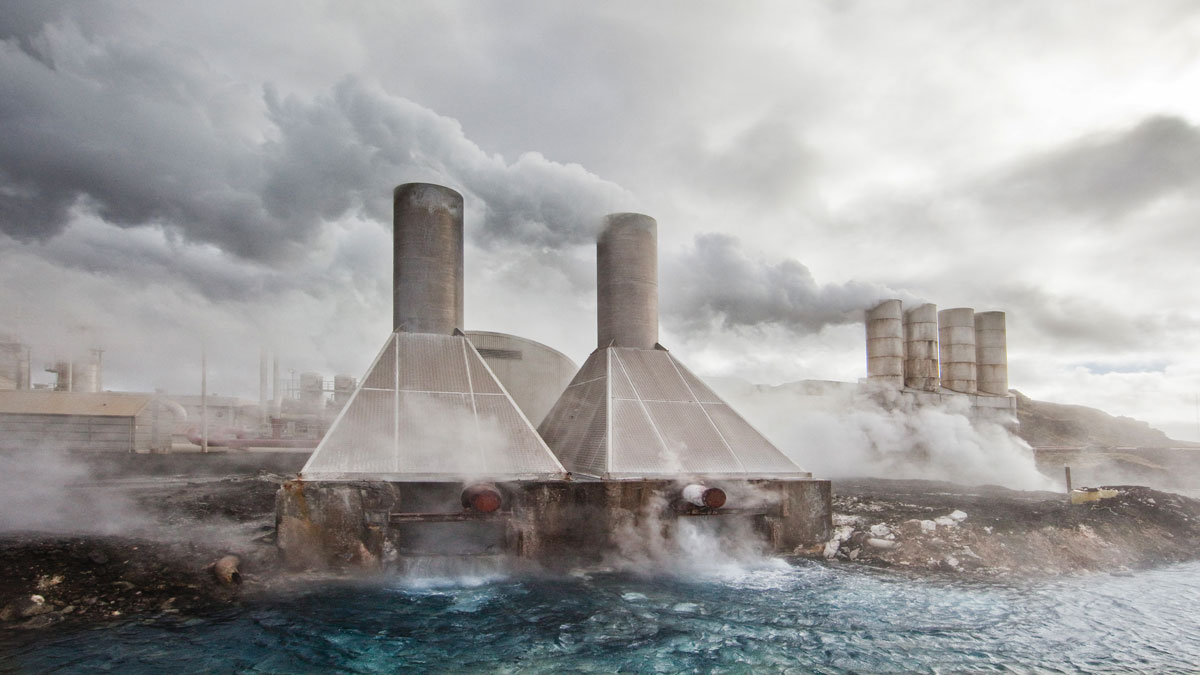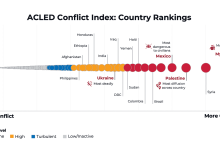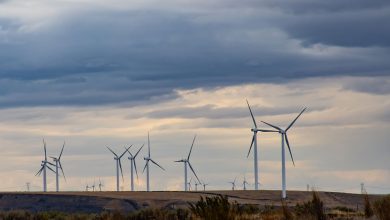Geothermal Energy: Revolutionary Energy Source for a Green Europe
For thousands of years, people have been using geothermal energy. For example, in ancient Rome it was used to heat rooms, including thermal baths. Today, it is an alternative to power plants based on fossil fuels and heating systems that emit significant amounts of greenhouse gases. And this potential is not limited just to Europe. At international level, research in the field of using geothermal energy is particularly developed in Island, Italy, the US, Israel, Japan, France, and New Zealand. The whole world is concerned about this issue, especially emerging countries, as besides the possibility to just produce energy this technology has another major advantage due to its geothermal reservoirs, able to store energy and CO2.
Types of geothermal energy
Depending on the depth of geothermal resources there are 3 types of geothermal energy.
- Very low geothermal energy (between 30 and 600 meters): water, at a very low temperature, requires the use of heat pumps for the direct heating of spaces. However, it can be used directly, especially for heating pools or greenhouses.
- Geothermal energy with low energy consumption (between 600 and 2,500 meters): the high-water temperature (between 30 and 90 degrees) allows its direct use to supply heating networks.
- High energy geothermal energy (over 2,500 meters): water exceeds 100 degrees and at such temperatures can even be used to generate electricity.
Cascade use of energy coming from geothermal water
Using energy in a cascade means the direct use of the energy of geothermal water from a geothermal well by several beneficiaries connected in series, each of them having as primary thermal agent thermal wastewater, discharged by the previous consumer. For example: electricity production, space heating, domestic hot water preparation, wood drying, milk pasteurization, stockfarming, fish farming, balneology, which lead to the recovery of waste heat with the help of heat pumps.
Types of geothermal systems
Geothermal systems are classified depending on temperature and pressure of the system and how thermal energy is transferred to the ground. The following types of geothermal systems are identified.
Hydrothermal convection systems
In the Earth’s crust there are radial channels through which a thermal agent circulates and transfers thermal energy from a deep eruptive source (magma) to the outside. These systems are particularly advantageous, as the potentials at which thermal energy is obtained are high and can be associated with the production of electricity. In these cases, the thermal agent obtained has a reduced content of gases (CO2 + H2S), which simplifies the recovery of heat. The obtained temperatures reach 240oC.
If the thermal agent is steam, it can be used directly in power plants, and if the thermal agent is water, it is transferred by convection to a second reservoir of variable size, located at depths small enough to be exploited by drilling.
The temperature of these reservoirs is variable and depending on its value there are:
– Geothermal reservoirs with temperature exceeding 150oC; they can be used to produce electricity
– Geothermal reservoirs with temperatures of 90 – 150oC for heating homes and for industrial processes
– Geothermal reservoirs with temperatures below 90oC, which can be used for local heating and preparation of domestic hot water
– Hot springs with temperatures below 70oC, used for therapeutic purposes and for the preparation of domestic hot water.
Geothermal water systems are about 20 times more common than steam systems and are usually found in volcanic regions with strong seismic activity. Geothermal water has a pronounced salt content, which varies widely. In the case of the use of industrial water in energy installations, due to the danger of deposition, in most cases surface heat exchangers are inserted. Although they degrade the energy level of the source, their use is necessary to avoid the deposition of salts in installations with the effect of deteriorating the heat transfer coefficient and clogging the free section of water passing through pipes. Heat exchangers transfer the mentioned effect in the primary circuit, in this case deposition and clogging occurring. Replacements and cleanings affect much smaller areas, with a favorable effect on maintenance and operating costs. Due to the seasonal nature of the thermal energy needs for heating homes, for the profitability of the operation additional consumers are used, such as: greenhouses, fish farms, pulp and paper processing facilities, drying facilities etc.
Conductive transfer systems
At quite low depths there are thermal reservoirs contained in impermeable rocks, with very low porosity. The availabilities provided by these reservoirs are much higher than those of hydrothermal convection systems.
Geopressured deposit systems
Water reservoirs covered with waterproof insulation are subjected to high pressures. Water contained in these reservoirs has a low salinity and is saturated with recoverable natural gas. These systems are spread throughout the world.
Geopressured systems can be used for both thermal and hydraulic purposes. The mechanical energy obtained by using hydraulic energy can be used to drive complementary mechanical installations in buildings, with a favorable effect on the overall efficiency of the system.
Magma systems
The molten volcanic rock is a large thermal source, which could be used to obtain thermal and mechanical energy.
Geothermal heat capture
There are many methods to collect natural and free energy of the Earth. The most common methods are closed loop and open loop. With any of them, only a fraction of energy comes from electricity, most of the energy coming from the earth itself. In conclusion, the price of use is smaller than for any other alternative for comfort.
Horizontal and vertical captors
Geothermal heat capture can be done using different methods, having two main categories of captors: horizontal and vertical (geothermal wells). With the help of the geothermal heat pump, 1kw of electricity consumed to supply the compressor is multiplied and recovered in the form of 3 to 5 kw of useful heat returned to the house through the heating system. The horizontal captors of the heating system need a minimum required area, the capture area being in direct proportion to the indoor area to be heated. Once the captors are installed, the excavation is obturated and the capture circuit becomes invisible. The land surface above the captors must remain free of construction, permeable to rainwater, snow, sunlight, and wind for the natural thermal regeneration of the ground. The minimum land area adjacent to the construction for capturing geothermal heat ranges between 100-180% of the indoor area to be heated, depending on the thermal power required for heating. The capture loops, once buried, have a durability of decades without any subsequent intervention. Groundwater capture involves a preliminary study of the hardness of the groundwater in the area (in the case of an ‘open loop’ circulation).
Another technique used is the ‘closed loop’ immersion of geothermal wells in capture probes. Vertical capture from groundwater involves the use of a ‘water-to-water’ heat pump. The vertical capture from the groundwater is done by drilling capture wells. This solution requires the existence of a minimum sufficient (and constant) groundwater flow throughout the year, especially in the cold period. The heat is taken from the groundwater present in the soil, usually at a depth of 10-20 m, where the water temperature is constant throughout the year.
A serious candidate with the potential of becoming part of the EU’s energy mix
In its continuous fight against climate change, the European Commission pays special attention to geothermal energy. CORDIS study includes the latest innovative research, funded by the EU, on both deep and surface geothermal energy. The study allows a faster and more efficient development of this potentially revolutionary alternative energy source.
Although so far, the funding levels for this form of renewable energy remained low compared to alternatives such as wind, solar and biomass, the funding amounts allocated have recently increased. For example, the Innovation and Networks Executive Agency (INEA) of the EU, which manages almost all projects in this results pack, has a total budget of EUR 172mln allocated to the geothermal energy project.
With the Green Deal, the Commission has established that Europe will become the first carbon-neutral continent by 2050 and in this context the impetus for the development and implementation of geothermal technologies as a serious and viable candidate with the potential to become part of the EU energy mix will gain ground.
CORDIS: 12 truly innovative projects
The 11 CORDIS results refer to the latest geothermal energy projects funded by the EU, to which a brief introduction to a still ongoing but very promising initiative was added, GEOTHERMICA. These 12 projects cover the full spectrum of geothermal energy research and provide a holistic overview of what the key priorities are for further development and investment in these technologies, so they become a vital source of alternative energy for Europe.
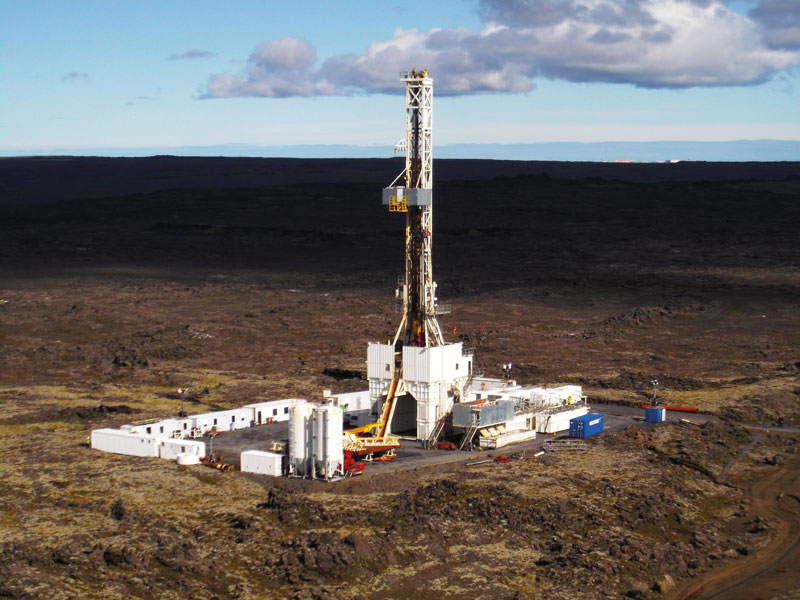
The project DEEPEGS is worth mentioning, for which test drilling was successfully performed in Island. It pursues the objective of improving geothermal systems so that the produced energy is no longer a marginal technology but become an essential one. In turn, the team of GEMex project collaborated with Mexican researchers to assess and characterize two sites in the Trans-Mexican Volcanic Belt to come up with efficient and feasible solutions to tap Mexico’s geothermal potential.

At the same time, the SURE project tested the use of radial water jet drilling – as a means of improving the size and economic viability of geothermal wells, and the GeoWell project developed and tested new reliable, economical, and environmentally friendly technologies that control high temperature geothermal wells.
Finally, the Cheap-GSHP, GEOCOND and GEOTeCH projects studied and launched new innovations aimed to make geothermal energy a clean energy source for heating buildings, while the MATChING project imposed itself as a spearhead for water cooling through innovative technologies in thermoelectric and geothermal power plants.
New and profitable materials for efficient geothermal energy systems in buildings
If we think about renewable energy options, maybe the first that come to our mind are photovoltaic panels. But a newcomer gains increasingly more attention in this sector: geothermal energy.
With the support of almost EUR 4mln coming from the European Union, through the GEOCOND project it is intended to materialize this potential. The consortium of the project has been working at shallow geothermal energy systems for buildings since 2017 and, given the tempting promises, these efforts seem justified.
“Shallow geothermal systems have several characteristics that arouse interest: they are electrical (heat pump), have the best possible efficiency and can be used simultaneously as heat source, cooling, and hot water. They are also easy to integrate in buildings, can be associated with other RES, such as heat and electricity sources. Their technology is robust, with the lowest maintenance costs. Shallow geothermal energy traditionally requires materials, such as PE100, which were not especially intended to it so their use for surface geothermal energy is far from optimal. Large providers of plastic materials were not interested in producing new compounds, probably because the size of this market was still too small. Therefore, an initiative such as GEOCOND was needed,” said Javier Urchueguia, Professor at the Polytechnic University in Valencia and coordinator of GEOCOND project.

There is a single problem. Due to the high initial cost, shallow geothermal energy systems have so far had little interest for end-users. GEOCOND is one of the many projects that aim to overcome this obstacle, specifically formulating new materials for the future installations of shallow geothermal system. Research conducted by GEOCOND covers four key elements at the heart of surface geothermal energy systems: plastic pipes whose conductivity needs to be optimized, joints of different sizes whose characteristics need to be improved, new materials for heat storage and new materials that increase the capacity of transferring heat from the ground.
Since the first year, the project yielded promising results. Among other things, the consortium proposed a new geometry for improving thermal efficiency, as well as a new algorithm for optimizing materials, considering the thermal, energy and economic variables.
Higher conductivity at a lower cost
The new plastic compounds in the project triple the conductivity of PE100 while maintaining their mechanical properties and other critical specifications related to weldability and workability. In cooperation with other projects aimed at solving problems inherent in surface geothermal energy systems, such as lack of training and adequate legislation and other technological constraints, GEOCOND is about to play a key role for European constructions.
Pros and cons
Geothermal energy can be used in two ways: to generate electricity or to generate heat. The first use is more in the industrial field, so in large industrial centers. The second use is rather related to the responsibility of local communities, of individuals and enterprises, which can launch projects to match their possibilities and needs. But what do professionals say about the disadvantages of this type of energy?
A geothermal power plant raises boiling water from the basement; on the one hand, the water is propelled into a hole; on the other hand, the natural warm water from the depths rises along a well. But this technology has two limits: first, the financial investments are quite high and then the yield of electricity production is quite low (to work, a geothermal power plant consumes, in turn, a lot of electricity).
A problem is drilling and sending water under pressure. This can cause cracks in the ground, and these cracks can lead to earthquakes! The same problem exists for the exploitation of shale gas or oil, by hydraulic fracturing. Therefore, the risk permanently remains higher than zero.
Specialists believe that only power plants are exposed to the risk of earthquakes, and this is significant for drilling between 1,500 and 5,000 meters deep. But when it comes to simple operation, the boreholes are much shallower – about 200 meters. This is named ‘surface geothermal energy’. The only risk at these depths is a drop in soil.
Despite the mentioned risks, the benefits are easy to see! Moreover, it is known that this energy hasn’t reach maturity yet, that it will be perfected and, without any doubt, in the years to come it will hold a main place in the new policy of energy transition.
The core of the planet is expected to remain warm for several billion years, making the earth an unlimited source of renewable energy. This energy is completely clean and natural; to generate electricity, geothermal power plants do not emit CO2. Moreover, unlike nuclear power plants, they leave no waste after use and do not require the import or storage of rare or dangerous fuels. Theoretically, this source of energy is available to all countries, all over the world. Finally, unlike green energy, such as solar or wind power, geothermal energy is not intermittent. Day or night, rain or shine, the warmth of the basement remains the same! Thus, in the case of a global energy transition, geothermal energy could be used as a reserve to compensate for fluctuations in solar and wind turbines.
To produce heat, geothermal energy is an advantageous choice, even if such system requires an investment. But once installed, the heat pump allows a reduction in energy consumption for heating and hot water production can be between 30% and 80%! This allows deep geothermal energy to replace regional power plants with baseload that are currently still based on oil and gas. Transition from conventional energy sources to deep geothermal energy allows a greater independence on imports of fossil fuels, such as oil or gas. Moving to this alternative without CO2 also helps avoid pollution with particles, unavoidable in heating systems using fossil fuels. Moreover, geothermal power plants occupy much less room than for example solar power plants providing the same supply levels. Therefore, in terms of land use too, deep geothermal energy is a quite promising energy form for the future. Finally, local use of deep geothermal energy brings added value at regional level: from the creation of new jobs and exploration of new energy sources and opportunities for know-how export to raising the standards of living thanks to low-emission heating technology.
Geothermal energy in Europe
Currently, there are over 5,000 heating networks in Europe, located mainly in Western Europe, Central Europe, and Scandinavia, of which only 280 are supplied with geothermal energy. But the potential of geothermal heating is much greater. A study that analyzed the potential and market conditions for geothermal district heating in 14 European countries shows that there are over 120 district heating networks of this type in Hungary, Slovenia, Croatia, and Slovakia alone, which are supplied with fossil fuels while being close to geothermal resources with temperatures of over 90°C at only 2000 meters below the ground. They are perfectly suited to explore deep geothermal energy for urban heating purposes.
These countries provide the possibility to switch from the old urban heating systems based on fossil fuels to supply with geothermal energy. This allows operators of heating networks to operate their heating systems not only in a manner that is more advantageous for consumers, but also independently of imports of fossil fuels, while creating added value for the region due to the supply of environmentally friendly heat.
Areas with high geothermal potential and low degree of capitalization in Romania
Regarding the geothermal potential, Romania ranks the third in Europe, after Greece and Italy. The areas with the highest natural geothermal potential in Romania are found in the Western Plain, respectively in the eastern part of the Pannonian Depression, where the crystalline foundation is at a shallow depth, respectively 800 – 1,000 m. Other areas with high geothermal potential are found in the lower Olt basin, Calimanesti – Caciulata area, in Dobrogea – south of the Harsova-Constanta alignment, as well as north of Bucharest, and in the Eastern Carpathians (Gutai-Tibles area and in the Ciuc depression) there are hot (T = 150oC at 3.000 m) and dry rocks. Many of these areas are located within petroleum exploration and/or exploitation blocks.
A source of heat is also the influx of high temperature water that comes from areas located at great depths and rises on the plane of major depth faults. This is also the case of the thermal aquifer north of Bucharest, which is fed by an important fault in Romania. It is the Intramoesian fault that starts in the Vidraru area, passes west of Moreni, east of Otopeni, Silistra and reaches the Black Sea at Shabla, Bulgaria. The category of petroleum structures with high natural geothermal gradient includes the structures from Arad – Timisoara and Oradea – Satu Mare, respectively the geological structures Bodrog, Calacea, Cherestur, Dinias, Dumbravita, Dudestii Noi, Foeni, Lovrin, Moravita, Pordeanu, Partos, Pecica, Santana, Sanmartin, Satchinez, Sandra, Sanpetru German, Socodor, Teremia, Toager, Turnu, Varias and Zimandu Nou. The oil structures Abram, Abramut, Curtuiseni, Chislaz, Ciumeghiu, Dijir, Derna – Budoi, Mihai Bravu, Marghita, Piscolt, Salacea, Scarisoara, Salonta, Suplacu de Barcau, Tinca and Viisoara are part of the Oradea – Satu Mare area.
And yet, in Romania the degree of capitalization of geothermal energy sources is low, mainly due to the lack of adequate financial funds for the development of this sector and the lack of firm and long-term users for the amortization of investments. Using geothermal energy for purposes other than balneotherapy began in the ‘70s, in the late ‘80s the fuel savings due to geothermal energy exceeding 50,000 toe/year.
As the largest resources of thermal waters are found in the west of the country, in that area there are also the most numerous and most important users of thermal water. Therefore, in Oradea municipality the company Transgex-Dafora ensures domestic water for over 3,500 apartments and almost 300 apartments are heated. Moreover, in Oradea there is also the National Center for Geothermal Research within the Oradea University, which holds a geothermal power plant. The source of thermal water is represented by the Triassic limestones and dolomites from 2,800 – 3,200 m depth, and the exploitation is done through 12 wells that produce about 140 l/second (about 12,000 m3/day), the surface temperature being 70 -105oC.
In Bihor County, in Beius, most buildings are heated with thermal water extracted by 2 wells with a total flow of about 120 l/sec. (>10.500 m3/day), the surface temperature being 80 – 85oC, and the quantity of thermal energy consumed exceeding 200.000 Gcal/year. It is noteworthy that the geothermal projects in Beius have been started since 1996 based on feasibility studies conducted by specialists from Germany, Iceland, and Denmark. The initial investments were financed by the Danish Environmental Agency and the Ministry of Environment and Sustainable Development in Romania, then important EU funds were used. In Beius there is an interesting geothermal project (Beius – green city project), which provides for the creation of a ‘balneotherapy park’ which includes a balneotherapy center, a thermal pool, a hotel, and restaurants for leisure.
Thermal waters from Neocomian are exploited in Baile Felix, but only for therapeutic purposes and in the pool within the resort. In Bors, thermal water is extracted from the Triassic limestones and dolomites from 2,500 m. 3 production wells and 2 injection wells are active; the total water flow is about 50 l/s (4,300 m3/day), the reservoir temperature is 130oC, and the water temperature at the well head is 95 – 105oC.
50 km south of Oradea is the Salonta – Ciumeghiu area where there is a geothermal water deposit at about 2,400 m, in Pannonian. The temperature of that deposit is 120 – 130oC, at the surface the temperature reaching 100 – 105oC. In the Arad – Timisoara area (Arad and Timis counties) the surface temperature of thermal waters is lower (40 – 80oC), so that the respective waters are used only locally, for heating, domestic hot water preparation, in some flax smelters and for therapeutic purposes. In the lower basin of Olt (Cozia – Caciulata area) there are 3 active wells with blowout production, with a flow of 20 – 25 l/sec. (1.800 – 2.200 m3/day), a pressure of 16 – 20 at and temperature of 90 – 95oC, both being at the surface. The source of thermal water is the sandy Senonian located at 1,900 – 2,000 m depth. This source has been exploited since 1994 and pressure is maintained at the initial values. The thermal potential of the 3 wells is 18 MWt, of which 3.5 MWt are due to gases dissolved in thermal water.
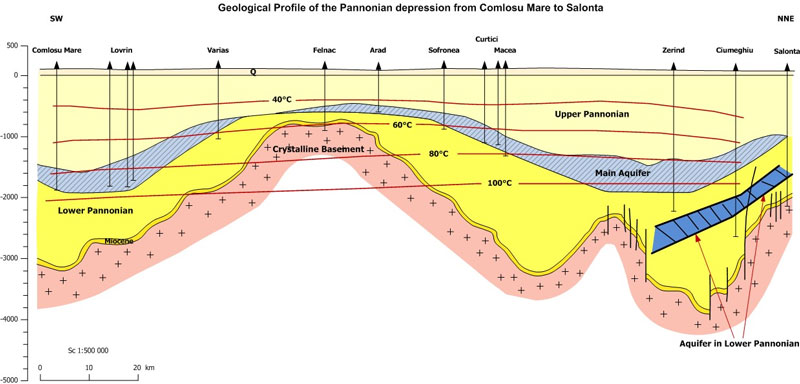
As regards the Capital, 13 wells have been drilled, of which 2 near the Snagov lake. The thermal aquifer is found in the Neocomian cracked limestones, located at 2,700 – 3,000 m depth where the temperature is 80oC. The formation water has a salinity of 1.5 – 2.2 g/l (150 – 220 kg/salt wagon) and contains hydrogen sulfide in small quantities (about 25 mg/). That is why the water is widely used in balneology. Currently there are only 3 active wells that supply the Foradex pool near the House of the Free Press in Bucharest and the THERME complex in Balotesti. The surface temperature is 75 – 80oC, and the flow is high. THERME complex includes thermal basins, steam saunas, swimming pool, hydromassage etc. It is a German project that required an investment of about EUR 30 million, of which about 20% are Romanian funds.
Success of the DARLINGe project
The DARLINGe project – Danube Region Leading Geothermal Energy 2017-2019 (designed in common for six Balkan countries) brought together the experience of specialists in the countries of the Danube basin to obtain a common and harmonized policy that will allow the region to become a leader of the correct use of geothermal water. Partners in the joint project were: The Federation of Bosnia and Herzegovina, Croatia, Hungary, Romania, Serbia, Slovenia, but also Republika Srpska as a component part of Bosnia and Herzegovina. In these countries, almost 30% of the extracted geothermal water is used for balneological and recreational purposes. The geothermal potential in the study area of the project (which in Romania refers only to the geothermal aquifer in porous and permeable rocks of Pliocene age) would allow a more efficient use of the temperature of the extracted geothermal water, in the so-called ‘cascades’ (to be mentioned that there were also water exploitations for agricultural purposes for heating vegetable greenhouses). The DARLINGe project was financed through the European Regional Development Fund ERDF (for EU partners) and through the Pre-Accession Instrument IPA (for non-EU Balkan partners). In Romania’s case, this comes in addition to the contribution of the Ministry of Regional Development and Public Administration, plus 2% own contribution.
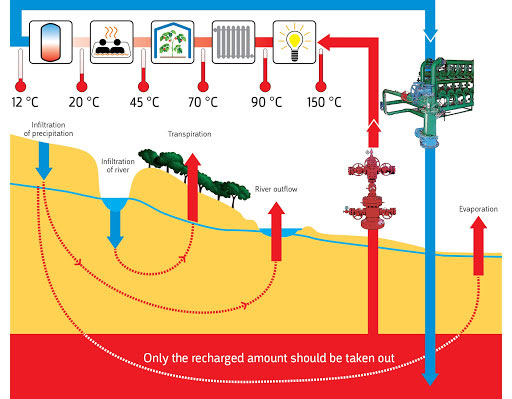
The DARLINGe project had in addition to a research component a component related to a positive change that the project aims to produce in the study area by raising awareness of all stakeholders, organizing information courses, and providing tools to help local governments and potential beneficiaries in the development of geothermal water projects. In addition to building a common strategy for the exploitation of such wealth, a fair valorization for the communities that have such resources in the basement was also pursued. At the level of the pilot area Hungary-Romania-Serbia, a numerical modeling at a detailed scale was provided to estimate the heat transfer and the effect of geothermal water exploitation through new wells (27 new wells are planned in Szeged, 9 for production and 18 for reinjection of geothermal water used in the same aquifer). For the Romanian part of the pilot area, the aim is to build a production well and a reinjection well at Lovrin, where local authorities are interested in using geothermal water to heat the town and some greenhouses, thus stimulating cascade use.
GeoDH market
Returning to Europe, among the over 5,000 district heating systems, more than 240 are systems with geothermal source (GeoDH), with a total installed capacity of over 4.3 GWth and a production of approximately 12,900 GWh. Under the conditions of the new technologies and technical solutions, the number of regions in which GeoDH solutions are implemented is on the rise. The applications start from those of small size (between 0.5 to 2 MWth) and reach 50 MWth. Some new GeoDH schemes also use shallow geothermal resource with high-capacity heat pumps.
Many GeoDH systems are based on favorable geothermal conditions, with high enthalpy and the extraction of geothermal energy in doublet systems. Modern doublet projects include two wells drilled in deviation from the same drilling field: a supply well and a return well. Geothermal fluid production is supported by production/feed pumps.
Installing GeoDH systems in high urban density areas improves their economic efficiency, as resource and demand are geographically correlated. A considerable challenge in the current context of economic crisis refers to the financing and development of new infrastructure networks for heat distribution. The rehabilitation of the existing ones is an alternative for the development of the GeoDH market.
The benefits of geothermal heating and cooling are flexible provision of energy from renewable sources at local level, diversification of the energy mix, protection against an increase in the price of fossil fuels. The use of geothermal resources is a source of economic development at national level through taxes, royalties, export of technology and jobs. The essential challenge is to promote geothermal district heating in Europe and facilitate its market penetration.
The European GeoDH market can be split into three segments:
- Mature markets. Several European countries have a long tradition in geothermal district heating and have set ambitious targets for 2020 in this field: Germany, France, Hungary, and Italy. To achieve these goals, it is necessary to simply the procedures and supplement the sources of funding.
- Markets in transition. This category includes several Central and Eastern European countries: Poland, Slovakia, and Romania, each with geothermal district heating systems installed. In these countries the potential is however much higher.
- Young markets. The third group of countries includes those in which the first GeoDH systems are being developed: The Netherlands, the United Kingdom, Ireland, and Denmark. In these countries, in absence of GeoDH tradition, the conditions for market development must be set. In other Central and Eastern European countries, including Bulgaria, the Czech Republic, and Slovenia, it is necessary to convince decision-makers and adopt a fair regulatory framework, but also to establish market conditions for the development of GeoDH systems.
Large capital investments
Geothermal heating systems involve large capital investments (CAPEX). The main costs are the initial investments in drilling production and return/injection wells, in surface and deep feed pumps, in distribution pipelines and networks, in monitoring and control equipment, in peak load takeover stations and in storage reservoirs. Operating expenses (OPEX) are however much smaller than in conventional systems, covering the cost of energy for pumping, expenses for system maintenance, operation, and control. The financial performance of the system depends on the density of the thermal load, or the heat demand per unit area. Superior economic benefits are achieved by combining heating with cooling, because in this case the resulting load factor is higher than for heating only, and the unit cost of energy is lower.
Production costs and selling prices are usually around EUR 60/thermal MWh, in a range from EUR 20 to 80/thermal MWh. It depends on the characteristics of the local geothermal resource (heat flow level, depth of location of the source), socio-economic conditions and pricing policies (kWht or m3 of hot water).
More than 25% of the EU’s population lives in areas where geothermal energy is available
In 22 European countries there are GeoDH systems in operation. Although the geothermal potential is recognized by some EU Member States in national renewable energy action plans, the real potential is significantly higher. To raise awareness, the GeoDH project assessed and presented for the first time the interactive map of geothermal potential in Europe. From the map it can be seen that: GeoDH applications can be developed everywhere and can be grafted onto existing district heating systems by replacing fossil fuels during their expansion or renovation. Also, new GeoDH systems can be built in many regions of Europe, at competitive costs, and the Pannonian Basin is of particular interest in the analysis of the GeoDH potential in Central and Eastern Europe.


